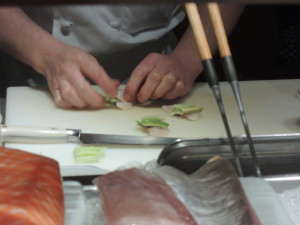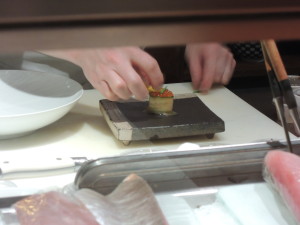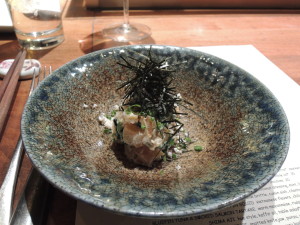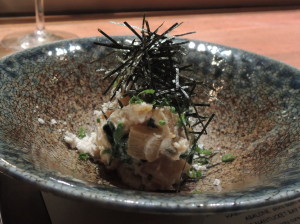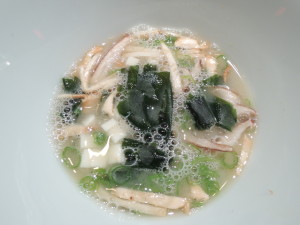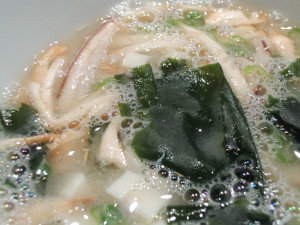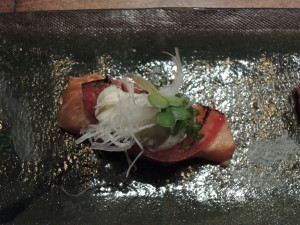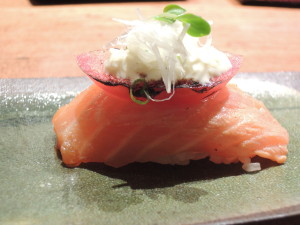The Herby Avocado BLT is a light, but filling meal. This sandwich oozes with an herbed avocado spread, juicy tomatoes, crispy bacon, and crunchy lettuce. While this sandwich is a year-round favorite of mine, making it with ripe heirloom tomatoes sweetened by the summer sun is a must try.
Avocado BLT’s
Yield: 2 sandwiches
Ingredients:
- 2 ripe avocados
- Dry sherry vinegar
- 2 medium tomatoes
- Fresh Basil (at least 20 leaves)
- Bacon (thick cut, hardwood smoked is best)
- Fresh Lettuce
- Coarse sea salt. I do mean coarse, see below:
- Optional: Fresh Dill (2 stems)
Step #1 – Chiffonade your basil. Take about 3 leaves and stack them on top of one another. Roll the leaves up into a tube. Run your knife laterally across the rolled up leaves. Voila! Ribbons of basil. Leaves vary by size, but I normally use about 20. You should yield a pile of basil roughly this size when done. See avocados for scale.
Step #2 – Bacon
Preheat your oven to 400 degrees Farenheit
Place Bacon on Baking Sheet – Pro tip: I usually put my bacon on a wire rack which I then lay over a baking sheet covered with parchment paper. There is less grease this way and I think it makes for cruchier bacon. If you don’t have a wire rack, you can put the bacon directly on the baking sheet.
Once the oven is preheated, put the bacon in for 10 minutes.
After 10 minutes, check the bacon. It will need to go for another 5–10 minutes depending on your oven and the thickness of the bacon. It should be crispy but not burnt by the end of the baking process. Total cook time will be 15-20 min. Your bacon should look like this:
Once the bacon is done, remove from the oven and let cool/crisp. If it’s on a wire rack, leave it. If the bacon is directly on the baking sheet, remove and place on a separate plate.
Turn off your oven and immediately add 4 slices of bread directly onto the oven rack for two minutes. This will warm and toast the bread for your sandwiches. After two minutes remove the bread and place on plates.
Step #3 – Avocado Spread
Make this after the bacon has cooked. For any avocado novices out there, this is a bad avocado:
Do not use one that looks like that.
These are good avocados:
Use avocados that look like that.
Take two avocados and slice them in half, laterally. Remove the pit. Use a regular sized spoon to scoop out the avocado flesh and add it to a non-reactive metal bowl like the one below.
Immediately add 1 tablespoon sherry vinegar and one half teaspoon of coarse sea salt.
Use your spoon to chop and mash the avocado into a paste, incorporating the sherry vinegar. Adding acid (in the form of vinegar) to the avocado spread keeps it from browning. It also tastes fantastic. Using the coarse sea salt helps to grind and mash the avocado.
Your avocado paste should look like this:
Add the basil and one half tablespoon sherry vinegar. Stir/incorporate well.
Add the dill to taste. I love dill so I usually add the feathery fronds from at least two stems. Please note, do not add the stems. Pull the fronds off with your fingers, tear if necessary, and add to the mix. Stir well to incorporate.
Step #4 – Tomatoes
Wash and slice your tomatoes laterally. See picture for thickness recommendation.
Step #5 – Lettuce
I buy pre-washed, prepackaged lettuce and recommend the romaine variety for this sandwich. The lettuce should be crisp, crunchy, and green.
Step #6 – Assembly
Take your toasty bread and generously smear with Avocado spread (see picture). The spread should be divided evenly between all four slices.
Place your tomato slices on the bread. Cut these slices to fit if they overlap (see picture).
Top tomato slices with bacon. Don’t be shy. This is one of the main ingredients and it always tastes amazing.
Top the bacon with lettuce. Pro tip – I like to “open” the lettuce leaves along the middle. Sometimes leaves curl towards the ends. By tearing slightly at the end of the leaf in its middle you can ensure the leaves lie flat on your sandwich.
Top the lettuce with your second slice of bread smeared with avocado.
Apply pressure to top of sandwich for 5 second count.
Enjoy!

















